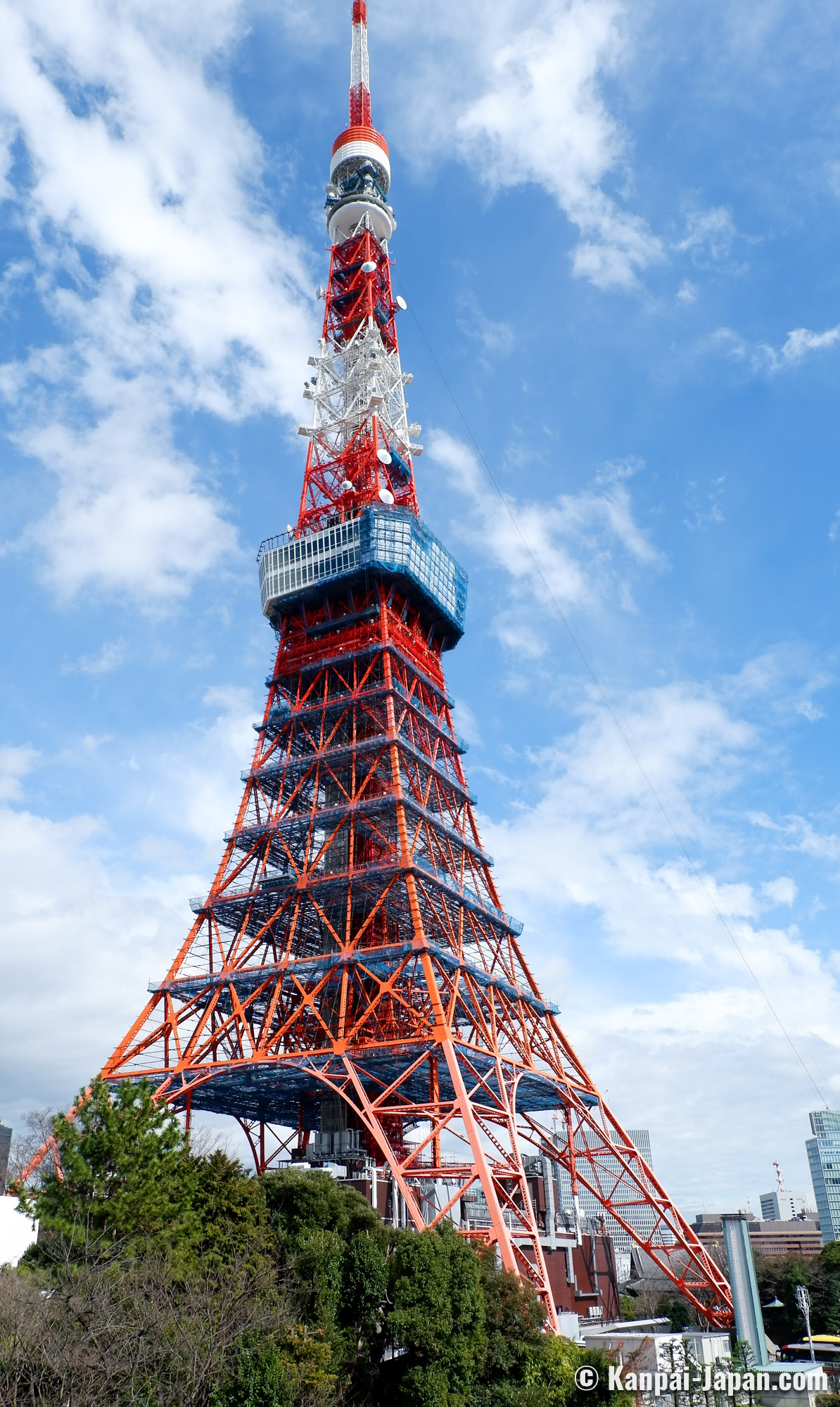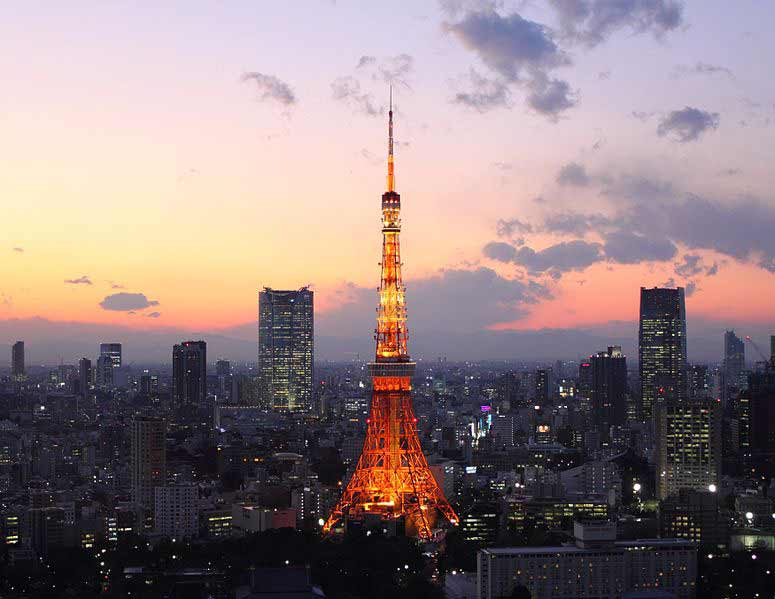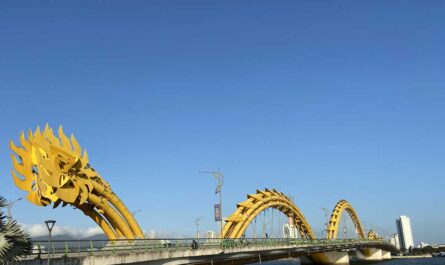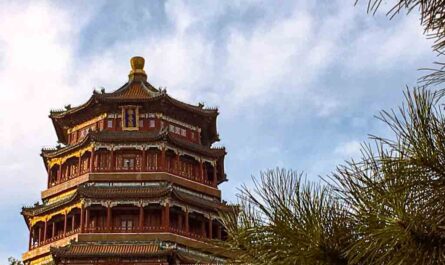Tokyo Tower is more than just a piece of metal and concrete; it is a symbol of Japan’s rich heritage, a hub of modern communication, and a canvas for artistic illumination. Its allure spans beyond practicality, as it offers an experience that captivates all who lay eyes upon it, whether by day or night. By the way, the real deal Top floor view from this tower, here is some more interesting information that gives you a better reason to pack your back to Tokyo!
Tokyo Tower Interesting, Fun Facts and Trivia
Tokyo Tower is not merely an architectural spectacle; it is a veritable tourist magnet, drawing in more than 3 million visitors annually. Since its inauguration in 1958, a staggering 150 million guests have been enchanted by Tokyo’s towering beauty, a testament to its enduring appeal. This remarkable statistic serves as a reminder of the tower’s significance, making it an integral part of Tokyo’s cultural landscape. Explore some other interesting facts about the Tokyo Tower:
1. Tokyo Tower: An Iconic Japanese Landmark
Tokyo Tower, situated in the vibrant Shiba-kin District of Minato, Tokyo, Japan, is a remarkable and iconic structure that has captured the imaginations of millions. Known by its Japanese name, Nippon Denpat, or “Japan Radio Tower,” this monumental edifice serves not only as a broadcasting tower but also as an observation point, providing an awe-inspiring view of the bustling city of Tokyo from a considerable height.
Visitors to Tokyo often find themselves drawn to this striking landmark, and it’s not hard to see why. The Tokyo Tower stands as a testament to both engineering marvel and architectural beauty. Its distinctive design and towering presence make it a must-visit attraction for anyone exploring the city.
2. A Landmark of Convenience and Beauty
Beyond its iconic status, Tokyo Tower serves a practical purpose as a broadcasting tower. Yet, it does so with a flair that is as captivating during the day as it is at night. The tower not only facilitates seamless communication but also offers a breathtaking sight to behold.
During the day, the Tokyo Tower stands as a beacon of architectural excellence, gleaming in the sunlight. Its intricately designed lattice structure and vibrant red and white color scheme create an unforgettable image against the Tokyo skyline. However, it is during the evening when the tower truly comes alive. As the sun sets, Tokyo Tower is illuminated, transforming it into a mesmerizing spectacle. The night lights of the tower are more than just illumination; they tell a story of a vibrant city that never sleeps.
3. Iconic Tokyo Tower: A Symbol of Tokyo
Standing tall amidst the city’s formidable skyline, the Tokyo Tower is a beacon of elegance with its captivating hues of orange and red. This iconic structure holds a unique place in the hearts of Tokyo’s residents, symbolizing their vibrant culture and unwavering spirit. Before the inception of the Tokyo Skytree, this tower reigned as the preeminent architectural marvel, soaring to a remarkable height of 333 meters by the year 2010. Even in the presence of newer competitors, the Tokyo Tower still stands proudly, an enduring testament to the city’s identity and legacy.
4. A Unique Resemblance to the Eiffel Tower: Towering Engineering Marvel
Remarkably, the Tokyo Tower bears a striking resemblance to the renowned Eiffel Tower in France, albeit standing 9 meters taller. This captivating structure tips the scales at a weighty 4,000 tonnes, yet it’s overshadowed by its French counterpart, the Eiffel Tower, which dwarfs it at a staggering 7,700 tonnes. Moreover, the Eiffel Tower utilized merely half the quantity of iron employed in the construction of the Tokyo Tower, underscoring the brilliance of Japanese engineering and design.
5. The Guinness World Records Museum: A Fascinating Archive of Human Achievement
The Tokyo Tower, a landmark that graces the Japanese skyline, not only stands as a testament to architectural marvel but also boasts a unique museum dedicated to the Guinness World Records. This museum, a treasure trove of human accomplishments, presents an array of intriguing exhibits that capture the essence of remarkable feats. Among the many enthralling displays, visitors will be captivated by life-sized statues portraying some of their beloved fictional characters. These statues, meticulously crafted, breathe life into the imagination.
Additionally, the museum features captivating photo panels that commemorate iconic moments of achievement. Furthermore, it showcases intricately designed models, painstakingly crafted by individuals from various corners of the globe. These models serve as tangible evidence of the remarkable records achieved worldwide, forming an integral part of the Tokyo Tower’s allure. The museum is a portal to a world of wonders, immersing guests in a realm where the extraordinary becomes the norm, making it one of the Tokyo Tower’s most mind-boggling attractions.
6. Tokyo’s Wax Museum: A Glimpse into Celebrities and Icons
Much like its British counterpart in London, Tokyo boasts its very own wax museum, the Tokyo Tower Walks Museum. This extraordinary museum, which first opened its doors to the public in the 1970s, offers visitors a unique opportunity to get up close and personal with life-like wax figures. What sets this museum apart is the fact that it has imported its exquisite wax models from the venerable wax houses of London.
These establishments take immense pride in their craft, sculpting not only figures of celebrities but also of revered religious leaders. The attention to detail in these wax figures is nothing short of astounding, rendering a lifelike quality that can leave spectators momentarily convinced that they are in the presence of real individuals. The Tokyo Tower Walks Museum, with its collection of wax icons, adds a touch of glamour and grandeur to the Tower’s offerings.
7. A Gallery of Illusions: Unveiling the Tokyo Tower’s Optical Marvels
Ascend to the top floor of the Tokyo Tower, and you will find yourself in a gallery of optical illusions, a space designed to captivate and challenge the senses. This gallery is renowned for its ability to play tricks on human perception, defying the boundaries of reality and the expected. As visitors explore the various exhibits, they are drawn into a world of bewildering visual phenomena, where the laws of physics seem to bend and warp. It is not merely a passive experience; the gallery boasts interactive objects that invite visitors to actively engage with these optical puzzles. As guests interact with these mind-bending exhibits, they are left both mesmerized and perplexed, showcasing the Tokyo Tower’s commitment to providing a multi-sensory experience that goes beyond the ordinary.
8. Riding the Elevator to New Heights: A Thrilling Journey to the Main Observatory
The Tokyo Tower’s elevator experience is not just a mundane mode of transportation; it is an adventure in itself. The journey commences at the base, aptly named Foot Town, and whisks passengers to the Main Observatory in mere seconds. This rapid ascent defies expectations and gives a taste of the tower’s commitment to creating memorable experiences. For those who desire an even more exclusive vantage point, a separate ticket grants access to the special observatory, accessible via another lift. The Tokyo Tower’s elevators, with their seamless operation and breathtaking views, add an exhilarating dimension to the overall experience, ensuring that the journey to the top is as exciting as the destination itself.
9. The Iconic Tokyo Tower’s Paint Renewal
About 7500 tonnes of fresh paint is meticulously applied to Tokyo Tower every five years, a captivating ritual that is both a testament to the commitment to its enduring allure and a practical measure to ward off the insidious corrosion of metal. This colossal undertaking, involving a staggering volume of paint, is a labor of love that ensures this iconic structure remains a breathtaking sight on the Tokyo skyline. This regular repainting not only preserves the tower’s structural integrity but also serves as a symbol of Japan’s unwavering dedication to maintaining the aesthetic splendor of its urban landscape.
10. The Mesmerizing Palette of Tokyo Tower
The Tokyo Tower stands resplendent in its striking combination of white and orange hues that adorn its lattice structure. This distinctive color scheme is a visual feast for all who gaze upon it and has firmly etched itself into the hearts of both locals and tourists. Remarkably, the choice of these specific paint colors is not merely an arbitrary decision but rather a meticulous adherence to international air protection regulations. These carefully selected hues, white and orange, have come to define the essence of Tokyo Tower, contributing to its iconic status. Under the moonlit sky, the tower takes on an ethereal radiance, beckoning admirers from near and far to bask in its nocturnal glory, an experience that is nothing short of enchanting.
11. The Unrivaled Vantage Point at Tokyo Tower
Ascending to the original observatory deck, perched 490 feet above ground, is a journey into the ethereal realm of Tokyo’s urban expanse. From this elevated vantage point, visitors are graced with an unparalleled 360-degree aerial view of the sprawling metropolis that unfolds beneath their feet. On clear, fortunate days, the observatory offers a breathtaking opportunity to glimpse the majestic Mount Fuji, standing sentinel on the horizon. Tokyo Tower’s lofty perch not only invites guests to take in the city’s grandeur but also to connect with Japan’s natural beauty, all from a singular and awe-inspiring location.
12. The Visionary Architect Behind Tokyo Tower
Tacha Nita, an acclaimed architect with an impressive portfolio of towering creations, is the brilliant mind responsible for the awe-inspiring Tokyo Tower. His innovative designs have left an indelible mark on the world of architecture. Drawing inspiration from the iconic Eiffel Tower in Paris, Nita embarked on a mission to craft a structure that would not only stand tall but also stand as a testament to human ingenuity.
With a penchant for pushing the boundaries of conventional design, Tacha Nita took his cues from the elegance of the Eiffel Tower. The intricate lattice of steel and the graceful proportions of the Parisian landmark served as the muse for Tokyo Tower. His meticulous attention to detail and his commitment to creating a structure that would be both aesthetically pleasing and structurally sound led to the birth of this remarkable edifice.
13. The Ever-Changing Radiance of Tokyo Tower
The Tokyo Tower is not just a static monument; it is a living work of art that adapts to the seasons and the emotions of the city. Every Tuesday, the tower transforms its illumination. During the frosty grip of winter, Tokyo Tower blazes with warm, fiery hues like vibrant oranges and radiant reds. This dynamic change in lighting serves to combat the chill in the air and infuses the city with a sense of warmth and vibrancy, a visual antidote to the cold.
Conversely, as summer approaches with its scorching embrace, the tower’s luminous palette shifts to a refreshing, primitive white. This alteration in illumination helps alleviate the sensation of heat that pervades the city during the sweltering summer months, offering a visually cool respite to the residents and visitors alike.
14. Exploring the Enchanted Surroundings of Tokyo Tower
The area surrounding Tokyo Tower offers an enchanting tapestry of experiences, divided into three distinct sections. The first of these sections, aptly named “Foot Town,” beckons visitors with a plethora of charming cafes, trendy restaurants, and an abundance of souvenir shops to satiate your shopping desires. A delightful surprise for manga and anime enthusiasts lies in this district, the One Piece Tower, a theme park inspired by the beloved manga and anime series. It promises an immersive experience that will captivate fans of all ages.
Rising above the bustling streets, the Main Observatory stands at a towering height of 150 meters, offering awe-inspiring panoramic vistas of the sprawling cityscape. An important note for the faint of heart: jumping is not recommended! But for the brave and adventurous, the Special Observatory awaits above, perched at a dizzying 250 meters. A visit to this lofty vantage point is a chance to behold Tokyo’s iconic Skytree and, if the weather permits, catch a glimpse of the majestic Mount Fuji on the distant horizon.
15. The Astounding Engineering Feat of Tokyo Tower
While Tokyo Tower may stand taller than its inspiration, the Eiffel Tower, it is significantly lighter. The question naturally arises: how can this be? The answer lies in the innovative use of pre-made steel and the remarkable advances in steel technology. Tokyo Tower, with all its grandeur, bears a featherweight of a mere 4,000 tonnes, approximately half the weight of its European counterpart, the Eiffel Tower. This remarkable feat of engineering showcases the ever-evolving prowess of architectural and structural innovation, and it stands as a testament to human achievement in the realm of towering landmarks.

16. A World of Attractions at Tokyo Tower’s Base
Beneath the grandeur of Tokyo Tower lies a bustling hub of attractions, a treasure trove of experiences that captivate visitors of all interests and ages. The vicinity at the tower’s base boasts a plethora of captivating sites, from immersive aquariums and thought-provoking galleries to insightful museums and charming souvenir stores. The vibrant enclave known as Freetown is an essential stopover for those seeking a diverse range of entertainment and cultural enrichment. Travelers can conveniently whisk themselves up to the tower’s lofty heights in an elevator that departs directly from the Fountain area, ensuring that every aspect of their Tokyo Tower adventure is nothing short of seamless and memorable.
17. From Broadcast Tower to Cultural Icon: Tokyo Tower’s Evolution
Intriguingly, Tokyo Tower wasn’t originally envisioned as a tourist attraction. Instead, it was conceived as a pivotal structure to facilitate broadcasting, a necessity arising from the inadequacy of antennas in Tokyo at the time to cover the entire region effectively. The prestigious Japanese national broadcaster, NHK, commenced operations in 1954, necessitating the construction of a more robust broadcasting tower. Additionally, the Japanese government sought to make a resounding statement, emblematic of their post-war resurgence and optimism. Hence, the Tokyo Tower was erected, and it remained Japan’s tallest edifice until the advent of the Tokyo Skytree in the 21st century. Tokyo Tower stands as a historical sentinel, mirroring Japan’s journey from recovery to the forefront of technological innovation.
18. A Tower of Fascinating Fun Facts
Tokyo Tower, aside from its visual allure, boasts an array of captivating facts and trivia that add depth to its significance. For instance, it stands at an impressive height of 333 meters, which is taller than its inspiration, the Eiffel Tower. The tower’s construction, which began in 1957, was an incredible engineering feat of its time. It took over three years to complete, a testament to the dedication and meticulous workmanship of its builders.
Additionally, the tower’s height is not its only claim to fame. It also hosts a wide array of entertainment options, from observation decks where visitors can take in panoramic views to restaurants and shops. Tokyo Tower has become more than just a landmark; it’s a hub of activity and culture that showcases the dynamic spirit of Tokyo.
19. Tokyo Tower: A Beacon of New Year’s Eve
On the cusp of a new year, as the clock strikes midnight, Tokyo Tower comes alive in a dazzling display of illumination. Amidst the dark canvas of the night sky, this iconic landmark stands tall, bearing witness to the passage of time. It is a tradition as old as the calendar itself, to adorn the tower with a conspicuous numeral representing the year that has just begun. This luminous spectacle serves as a beacon of hope and anticipation for all those who gather in its shadow to bid farewell to the past and embrace the possibilities of the future.
20. Noppone: Tokyo Tower’s Adorable Mascots
For denizens of Tokyo, this towering structure holds not only the promise of a new year but also the presence of two endearing mascots, Noppone. These charming characters, akin to siblings, are a delight to the young and the young at heart. The elder of the two, easily identifiable by his blue hinges, is a symbol of tradition and steadfastness, while the younger, sporting red wings, represents the spirit of innovation and the endless quest for progress. Their creation on December 23, 1998, coincided with Tokyo Tower’s 40th anniversary, and they have since become an integral part of the tower’s identity, embodying its rich history and bright future.
21. Tokyo Tower in Anime and Manga: A Cultural Icon
If you are an enthusiast of anime or manga, you are likely to have encountered Tokyo Tower in the pages of your favorite comics or the frames of animated series. This towering structure has ingrained itself into the fabric of Japanese pop culture, making countless appearances in beloved works. From the emotionally charged “Tokyo Magnitude 3.0” to the enchanting “Cardcaptor Sakura,” and the dark and mysterious “Death Note,” Tokyo Tower serves as a backdrop to the unfolding tales of heroism, romance, and intrigue. Its presence in these mediums, along with numerous others such as “Magic Night Rawarth,” “Please Save My Earth,” “Digimon,” “Detective Conan,” “Sailor Moon,” and more, testifies to its enduring significance as an emblem of Tokyo’s vibrant and ever-evolving cultural landscape.
22. Recycling Marvel: Tokyo Tower’s Transformation During the Korean War
Recycling stands as a testament to human ingenuity, where the metamorphosis of materials breathes life into new structures. An epitome of this transformative prowess can be found in the Tokyo Tower, an iconic landmark that emerged as an emblem of hope during the tumultuous Korean War. The very essence of reusing resources came to the fore when the damaged steel from military tanks was repurposed to give rise to the grandeur that is the Tokyo Tower. This remarkable feat symbolizes the resilience of the human spirit, encapsulated within the steel girders that now soar into the Tokyo sky.
23. Nature’s Wrath and Tokyo Tower’s Resilience
As history has witnessed, nature’s fury can be as unforgiving as it is unpredictable. The Tohoku earthquake, an unrelenting force of devastation, left an indelible mark on the Tokyo Tower. Its antennas, reaching for the heavens, bowed in reverence to the earthquake’s power on that fateful day, March 27th. To rectify this architectural marvel’s noble posture, the antenna was carefully disassembled in July 2002.
Regrettably, this endeavor exacted a toll on the tower’s stature, causing it to shrink from its original height of 333 meters to a somewhat humbler 315 meters. However, this was merely a momentary setback, as a monumental restoration effort saw the antenna reinstalled with renewed vigor in 2014, resurrecting the Tokyo Tower to its full splendor. Aviasales: A trusted service for buying flight tickets from reliable agencies at the lowest possible rates
24. Craftsmanship and the ‘Toby’ Legacy
Behind every colossal creation lies a legion of skilled artisans, and the Tokyo Tower was no exception. Traditional Japanese craftsmen, known as ‘Tobies,’ were the unsung heroes of this monumental project. These skilled individuals brought their rich heritage and artisanal expertise to bear upon the construction of the tower. Each day, the construction site resonated with the collective effort of at least 500 Tobies, who meticulously shaped and assembled the tower’s components. Their dedication and craftsmanship ensured that the Tokyo Tower stands not just as a towering symbol of modernity but as a tribute to Japan’s enduring traditions and the hands that built it.
25. Illuminating Tokyo Tower’s Special Lighting Events
Tokyo Tower, an iconic symbol of Japan’s capital city, consistently captivates with its dazzling light displays during special events. The Tokyo Tower’s Main Observatory frequently takes center stage in these mesmerizing spectacles. An unforgettable example of this is the extraordinary “White Band Day” on September 7, where the entire lighting system, save for the resplendent Main Observatory, is gracefully dimmed, illuminating it in pristine white lights. This striking transformation turns Tokyo Tower into a radiant beacon of light that can be seen from afar. Moreover, for external observers, the use of Windows provides a canvas for displaying various names, lending a personalized touch to the tower’s luminous visage. Adding an artistic dimension to these events, Tokyo Tower has occasionally featured intricate illuminations like hearts, among other captivating designs, to underscore the significance of particular occasions.
26. The Tokyo Tower’s Remarkable Transformation
One lesser-known facet of Tokyo Tower’s history is the closure and renovation of its specialty decks, particularly the top deck, in 2016. This vital restoration project aimed to enhance the visitor experience and bring the tower’s facilities up to date. During this period, the specialty decks were temporarily inaccessible, much to the disappointment of tourists and enthusiasts. However, their patience was rewarded when, two years later, on the 28th of 2018, the specialty decks were reopened in a grand unveiling. A remarkable aspect of this reopening is that there were discussions about renaming both decks, marking an intriguing chapter in Tokyo Tower’s evolution. This transformation illustrates the tower’s commitment to not only preserving its heritage but also adapting to modern demands, making it a continuously engaging destination for both locals and visitors alike.
27. Lighting Up the Future: Tokyo Tower’s Illuminating Transformation
The passage of time often necessitates adaptation, even for the most iconic landmarks. Tokyo Tower, after gracing the skyline for three decades, found itself facing a challenge – a significant decline in its visitor numbers and revenue. The Japanese government, recognizing the need for rejuvenation, sought to infuse new life into the Tokyo Tower by reinventing its lighting system.
To undertake this formidable task, they enlisted the renowned Japanese designer, Ishii. His creative genius breathed fresh vitality into the Tokyo Tower’s illumination, making it more captivating than ever before. This reimagining not only breathed new life into the tower but also rekindled its allure, beckoning both locals and tourists alike to witness the grandeur of this enduring symbol of Japan. Compensair: A service that helps customers receive compensation for flight delays, cancellations, or denied boarding
28. The Tale of Tokyo Tower and SkyTree: A Towering Endeavor
The story of Tokyo Tower is not one of stagnant heights but rather a tale of ambitious aspirations and adaptations. Tokyo Tower, originally conceived to stand taller than the iconic Empire State Building, soaring at an impressive 381 meters, sought to reach for the skies and claim the title of the world’s tallest building. However, the path to this towering success was fraught with challenges. Insufficient funding and a scarcity of the right materials hindered the realization of this grand vision.
Moreover, as Tokyo’s urban landscape evolved, the proliferation of skyscrapers threatened the effectiveness of Tokyo Tower’s signal transmission to the city’s remote areas. In response to this challenge, a newer and taller version emerged in 2012, aptly named SkyTree. This architectural marvel, reaching a towering height of 634 meters, now bears the responsibility of relaying vital signals and information to a metropolis that continues to expand. Tokyo Tower’s legacy, though not without its setbacks, remains a testament to the enduring spirit of innovation and adaptability in the face of changing times.
More Interesting Articles
- Capital Cities in Europe and Their Countries – Complete List
- Countries in South America and Their Capitals – Complete List
- List of Countries by Population – Most or Least Populous Nations
- Countries in North America and Their Capitals
- Capital Cities in Asia – List of Asian Capitals with Countries
- List of Capital Cities in Africa and Their Countries
- Capitals of Oceania – List of Oceanian Country Capitals
- World Cities by Population – Megacities | Density | Largest Cities
- Continents by Population – Global Population Factsheet
- 60 US States Interesting Fun Facts and Information
- 70 Interesting Latin American Facts Everyone Should Know
- 69 Awesome Interesting Fun Facts about the Greek Empire
- 85 Awesome Hagia Sophia Turkey Interesting Fun Facts
- 116 Interesting Fun Facts About Orlando Florida USA
- 60 Kuala Lumpur City Malaysia Interesting Fun Facts
- 83 Turkish Ottoman Empire Interesting Fun Facts
- 50 Beautiful Bali, Indonesia – Interesting Fun Facts
- 124 Interesting Fun Facts About Toronto Canada
- 66 Interesting Facts – Amer Fort – Amber Fort – Rajasthan India
- 45 Interesting Fun Facts About Surabaya Indonesia



